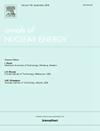Effect of laser powder bed fusion process parameters on the microstructure and properties of pure tungsten
IF 1.9
3区 工程技术
Q1 NUCLEAR SCIENCE & TECHNOLOGY
引用次数: 0
Abstract
Tungsten's exceptional properties are offset by manufacturing challenges for complex components due to its high melting point and brittleness. Laser powder bed fusion (LPBF) offers a solution, yet process-induced defects remain problematic. This study systematically investigated the effects of hatch spacing, scan speed, and laser power on the density, microstructure, mechanical properties, and thermal conductivity of LPBF-fabricated tungsten. Results demonstrate that Laser power dominantly controls densification, with optimized parameters achieving 98.5% density. Resultant properties include 406.4 HV hardness, 1031 MPa compressive strength, and 164.1 W/m·K thermal conductivity. Despite these strengths, unavoidable microcracks (attributed to high ductile-brittle transition temperature and impurities) limit tensile strength to 293.1 MPa. These findings validate LPBF's capability for refractory metal processing while highlighting the critical need for crack suppression strategies in high-performance applications..
激光粉末床熔合工艺参数对纯钨组织和性能的影响
由于钨的高熔点和脆性,钨的特殊性能被复杂部件的制造挑战所抵消。激光粉末床熔融(LPBF)提供了一种解决方案,但工艺引起的缺陷仍然存在问题。本研究系统地研究了舱口间距、扫描速度和激光功率对lpbf制备的钨的密度、微观结构、力学性能和导热系数的影响。结果表明,激光功率对致密化起主导作用,优化后的参数可达到98.5%的密度。所得性能包括硬度406.4 HV,抗压强度1031 MPa,导热系数164.1 W/m·K。尽管具有这些强度,但不可避免的微裂纹(归因于高韧脆转变温度和杂质)将抗拉强度限制在293.1 MPa。这些发现验证了LPBF在难熔金属加工方面的能力,同时强调了高性能应用中裂纹抑制策略的关键需求。
本文章由计算机程序翻译,如有差异,请以英文原文为准。
求助全文
约1分钟内获得全文
求助全文
来源期刊

Annals of Nuclear Energy
工程技术-核科学技术
CiteScore
4.30
自引率
21.10%
发文量
632
审稿时长
7.3 months
期刊介绍:
Annals of Nuclear Energy provides an international medium for the communication of original research, ideas and developments in all areas of the field of nuclear energy science and technology. Its scope embraces nuclear fuel reserves, fuel cycles and cost, materials, processing, system and component technology (fission only), design and optimization, direct conversion of nuclear energy sources, environmental control, reactor physics, heat transfer and fluid dynamics, structural analysis, fuel management, future developments, nuclear fuel and safety, nuclear aerosol, neutron physics, computer technology (both software and hardware), risk assessment, radioactive waste disposal and reactor thermal hydraulics. Papers submitted to Annals need to demonstrate a clear link to nuclear power generation/nuclear engineering. Papers which deal with pure nuclear physics, pure health physics, imaging, or attenuation and shielding properties of concretes and various geological materials are not within the scope of the journal. Also, papers that deal with policy or economics are not within the scope of the journal.
 求助内容:
求助内容: 应助结果提醒方式:
应助结果提醒方式:


